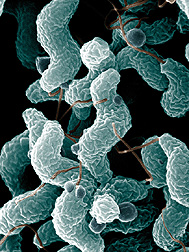



New Campylobacter-Detecting Medium Licensed
US - A quicker, simpler way to distinguish between Campylobacter species has now been licensed for manufacture by two U.S. companies. The new culture medium called Campy-Cefex is specifically designed to detect and differentiate C. jejuni and C. coli mixtures of food-contaminating microbes. These two bacteria are important causes of foodborne illness.Agricultural Research Service (ARS) microbiologist Norman Stern, with the ARS Poultry Microbiological Safety Research Unit (PMSRU) in Athens, Ga., began developing the new medium in 1987. That’s when he traveled to Poland to work with researchers Boleslaw Wojton and Kris Kwiatek at the Veterinary Research Institute in Pulawy, Poland.
 |
| This scanning electron microscope image shows the characteristic spiral, or corkscrew, shape of Campylobacter jejuni cells and related structures. Campylobacter bacteria are the number-one cause of food-related gastrointestinal illness in the United States. |
They worked cooperatively to characterize Campylobacter contamination in poultry. Previous media for detection of Campylobacter relied upon the use of new antibiotics that were unavailable in Poland. In developing the medium, Stern used the only two he had brought with him—cycloheximide and cefoperazone.
Surprisingly, the two compounds provided superior efficacy, not only for growing Campylobacter in a culture, but also for repressing the growth of most other microorganisms. The additional antibiotics previously employed with other Campylobacter media were not needed.
A patent for the Campy-Cefex culture medium was awarded in 1999 to Stern, with Wojton and Kwiatek listed as co-inventors. Now licensing agreements to produce the new culture medium have been entered into with Becton Dickinson and Company, Franklin Lakes, N.J., and Neogen Corporation, Lansing, Mich.
Campy-Cefex selects for Campylobacter among competing flora in a sample, cultivating colonies that resemble tiny water droplets. From these, microbiologists can estimate the level of Campylobacter contamination in the sample.
PMRSU’s technical staff trained several U.S. Department of Agriculture regulatory agency employees in the use of the media and techniques for Campylobacter enumeration for research studies.
ARS is the USDA’s chief scientific research agency.
Further Reading
|
|
- Find out more information on Campylobacter by clicking here. |








